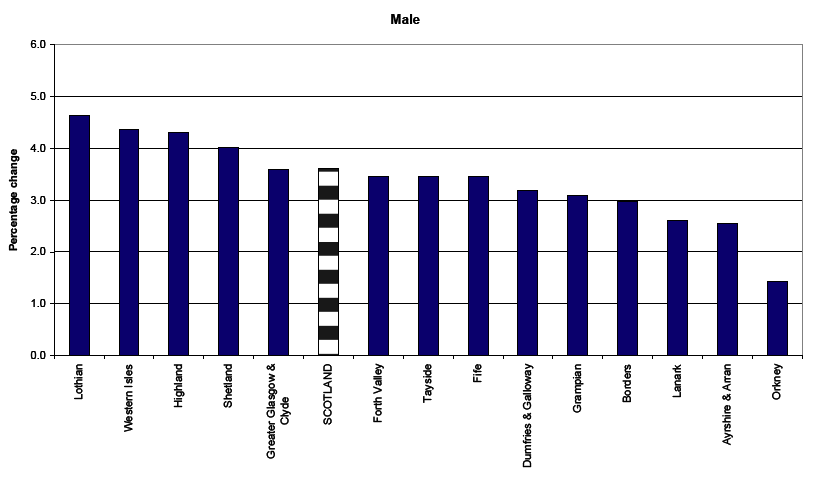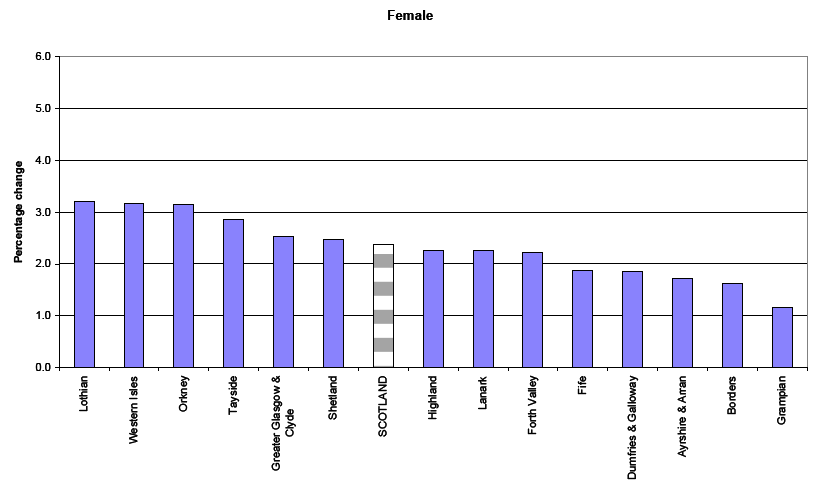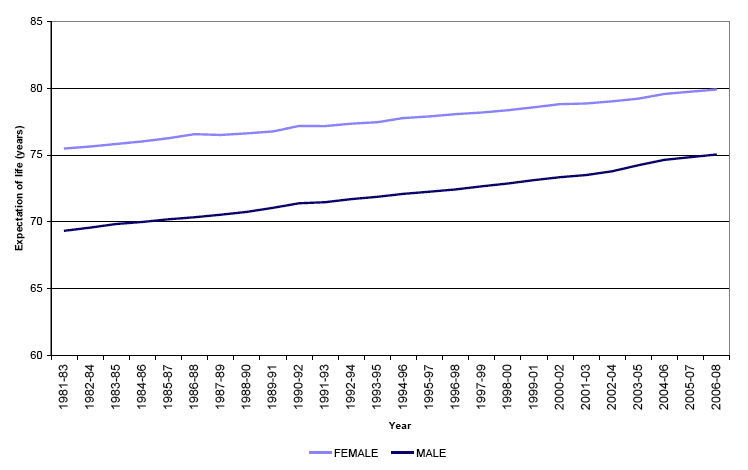
3.1 The Scottish Picture: Changes over time
3.1.1 Life expectancy at birth provides a useful summary measure of mortality rates actually experienced over a given period. It also provides an objective means of comparing trends in mortality, over time, between areas of a country and with other countries. This is of particular use in monitoring and investigating health inequality issues across Scotland and in setting public heath targets. One of the Government’s current targets is to increase healthy life expectancy at birth in the most deprived areas. Healthy life expectancy is derived by combining estimates of life expectancy with data on self-assessed health (from surveys). Another related Government target is to reduce mortality from coronary heart disease among the under 75s in deprived areas. The incidence of mortality from coronary heart disease has an impact on estimates of life expectancy.
3.1.2 Figure 1 shows that the expectation of life at birth in Scotland has improved over the last 20 years or so. It has increased from 69.3 years for males born in the period 1981-1983, to 75.0 years for those born in 2006-2008, an increase of 5.7 years. For females, life expectancy has increased from 75.5 years for those born in the period 1981-1983, to 79.9 years for those born in 2006-2008, an increase of 4.4 years.
Figure 1 Life expectancy at birth, Scotland, 1981-1983 to 2006-2008

3.1.2 Figure 1 also shows that the gap between life expectancy at birth for men and women is slowly closing, dropping from 6.2 years in 1981-1983 to 4.9 years in 2006-2008.
3.1.3 Life expectancy figures for Scotland are also produced by the Office for National Statistics (ONS) using single years of age rather than grouped years. For more details see Section 4.1.
3.2.1 Figure 2 shows that Scottish men and women have among the lowest expectation of life at birth in the EU-271. The majority of countries with lower life expectancy than Scotland were Eastern European states which joined the EU on 1 May 2004 and 1 January 2007. For Scottish men, expectation of life is 0.8 years lower than the EU average. For women, life expectancy is 2.0 years lower. For both sexes, the expectation of life is 4.0 to 4.5 years lower than the EU countries with the highest life expectancy.
3.2.2 The average life expectancy at birth for the whole of the UK, based on the latest available figures (2005-2007), is 77.3 years for men and 81.7 years for women (see Figure 2). Only four Scottish Council areas have a higher male life expectancy than the UK average - East Renfrewshire, Aberdeenshire, Perth & Kinross and East Dunbartonshire. For females, only East Renfrewshire and East Dunbartonshire have a higher life expectancy than the UK average.
Figure 2 Life Expectancy at birth, 2007, selected countries

3.3 Life Expectancy at Birth, 2006-2008, geographical variations
3.3.1 Table 1, Table 2 and Table 3 show life expectancy at birth in Scotland for 2006-2008 for Council and NHS Board areas.
3.3.2 For men, the Council area with the lowest life expectancy was Glasgow City (70.7 years), and the Council area with the highest life expectancy was East Dunbartonshire (78.0 years), 7.3 years more than Glasgow City.
3.3.3 For women, East Dunbartonshire also had the highest life expectancy (82.5 years), 5.3 years more than Glasgow City, the area with the lowest figure (77.2 years).
3.3.4 Of the NHS Board areas, the lowest life expectancy for men and women was in Greater Glasgow & Clyde (72.7 and 78.6 years respectively).The NHS Board area with the highest male life expectancy was Borders (77.1 years) and the highest female life expectancy was Shetland (81.5 years).
3.4 Life Expectancy at age 65, 2006-2008, geographical variations
3.4.1 Table 6 shows life expectancy at age 65 for Scotland and its administrative areas and has been ranked for ease of presentation. This shows that, for Scotland, men aged 65 could expect to live a further 16.3 years and women a further 18.9 years if mortality rates remain the same as they were in the period 2006-2008.
3.4.2 For men and women, the Council area with the lowest life expectancy at age 65 was Glasgow City (13.8 years and 17.4 years respectively). The Council area with the highest life expectancy at age 65 for men and women was Shetland (17.9 and 20.4 years respectively), 4.1 years for men and 3.0 years for women more than Glasgow City.
3.4.3 The NHS Board area with the lowest life expectancy at age 65 for men and women was Greater Glasgow & Clyde (15.0 and 18.1 years respectively). The NHS Board area with the highest life expectancy at age 65 for men and women was Shetland (17.9 years and 20.4 years respectively), this was 2.9 years for men and 2.3 years for women more than Greater Glasgow & Clyde.
3.5.1 Life expectancy at birth, like most statistics, is an estimate which is subject to a margin of error. The accuracy of the results can be indicated by calculating a confidence interval which provides a range of values within which the true underlying life expectancy would lie (with 95% probability).
3.5.2 The 95% confidence intervals for life expectancy at birth and at age 65 are given in Table 7 and Table 8, and are illustrated in Figure 3, Figure 4, Figure 5 and Figure 6 for Council and NHS Board areas within Scotland.
3.5.3 There is no simple "rule of thumb" for the size of confidence intervals, although it largely depends upon the size of the population: areas with small populations tend to have wider confidence intervals. It is also worth noting that life expectancy results in these areas can be affected by the random variation in the annual number of deaths. This means that the results can be erratic and vary from period to period. For example,
in Table 1, Table 2 and Table 3, changes in rank may simply be due to random variation from year to year in the population and number of deaths (particularly in the smaller areas such as Orkney and Shetland) as opposed to a real change in the number of years one can expect to live.
3.5.4 More information about the methods used to calculate the standard errors and confidence intervals used in this report can be found in the ONS methodology paper "Life expectancy at birth: methodological options for small populations". See Section 4.2.4 for details of how to access this report.
Figure 3 Life expectancy at birth, 95% confidence intervals for Council areas, 2006-2008 (Males and Females)
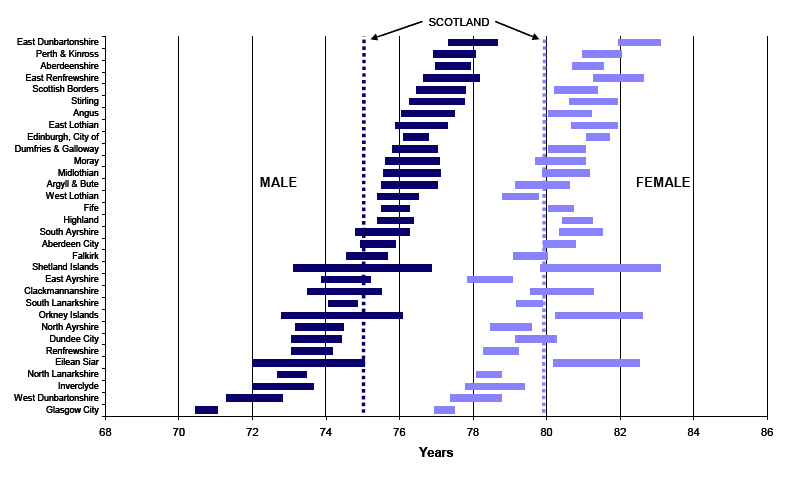
Figure 4 Life expectancy at birth, 95% confidence intervals for NHS Board areas, 2006-2008 (Males and Females)
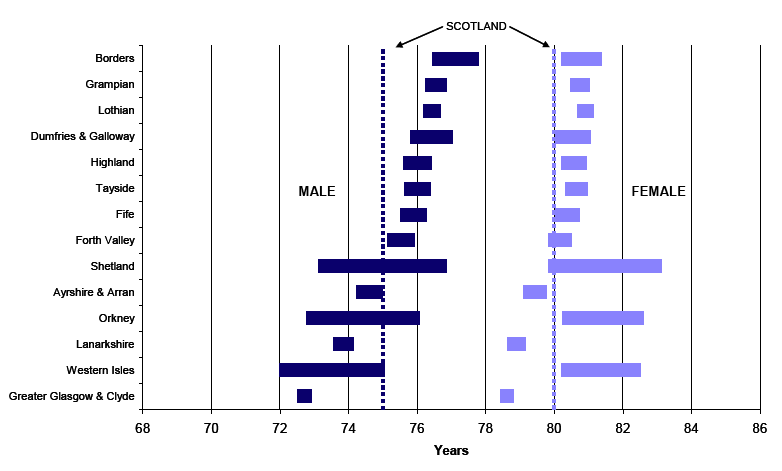
Figure 5 Life expectancy at age 65, 95% confidence intervals for Council areas, 2006-2008 (Males and Females)
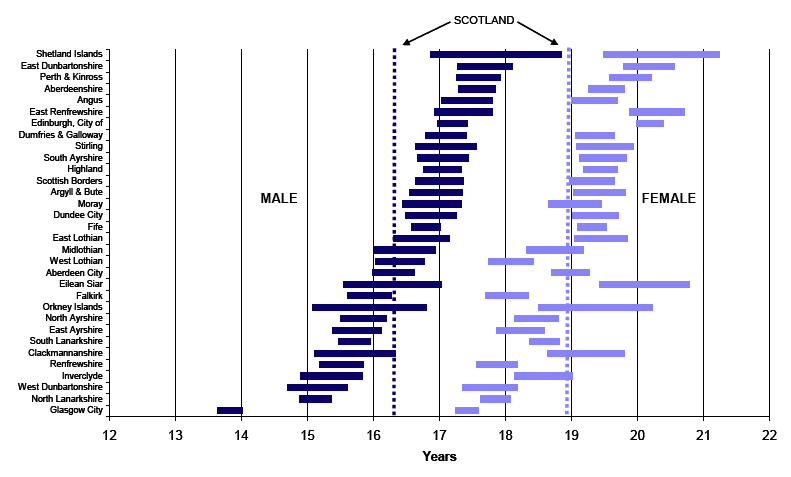
Figure 6 Life expectancy at age 65, 95% confidence intervals for NHS Board areas, 2006-2008 (Males and Females)
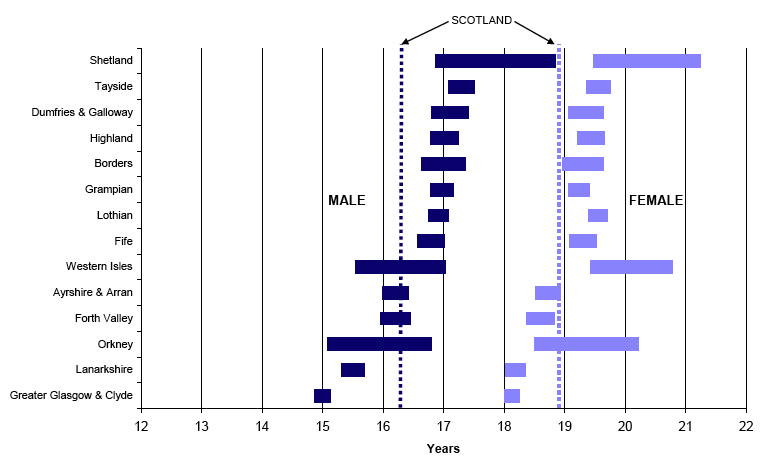
3.6 Life expectancy at birth, comparisons between 1996-1998 and 2006-2008
3.6.1 In the ten years since 1996-1998 life expectancy at birth in Scotland has increased by 2.6 years for men (from 72.4 years to 75.0 years), and 1.9 years for women (from 78.1 years to 79.9 years). Table 1, Table 2 and Table 3 show the highest and lowest ranking Council and NHS Board area for both periods. The tables also show the gap in life expectancy between men and women is closing, from 5.6 years in 1996-1998 to 4.9 years in 2006-2008.
3.6.2 For males, the gap between the Council area with the highest life expectancy and the Council area with the lowest life expectancy has decreased by 0.2 years — from 7.5 years in 1996-1998 to 7.3 years in 2006-2008. For women, the gap has increased by 0.4 years — from 4.9 years in 1996-1998 to 5.3 years in 2006-2008.
3.6.2 The maps in Figure 7a and Figure 7b and the charts in Figure 7c show the percentage change in life expectancy over the 10 year period for Council areas. For men, life expectancy increased the most in West Lothian — by 5.6 per cent (4.0 years), while Orkney had the smallest increase with 1.4 per cent (1.1 years). For females, life expectancy increased the most in East Dunbartonshire — by 3.8 per cent (3.1 years), and Moray had the lowest increase with 0.6 per cent (0.5 years).
3.6.3 The maps in Figure 8a and Figure 8b and the charts in Figure 8c show similar information for NHS Board areas. For men, Lothian had the largest increase with 4.6 per cent (3.4 years) and Orkney the smallest with 1.4 per cent (1.1 years). For women, Lothian also had the largest increase with 3.2 per cent (2.5 years) and Grampian the smallest with 1.2 per cent (0.9 years).
3.6.4 Over the 10 year period, the ranking of many Council and NHS Boards has changed (Table 1, Table 2 and Table 3). For men, West Lothian Council area has risen 11 places to 14th while Orkney has fallen 13 places to 24th. East Dunbartonshire has replaced East Renfrewshire as the Council area ranked number 1 for male life expectancy. For women, Edinburgh has risen 11 places to 6th, while Moray has fallen 16 places to 19th. East Dunbartonshire has replaced Aberdeenshire as the Council area ranked number 1 for female life expectancy.
3.6.5 Of the NHS Board areas, for men, Lothian and Highland have risen 4 places to 3rd and 5th respectively and Orkney has fallen 6 places to 11th. For women, Lothian has risen 7 places to 4th and Grampian and Dumfries & Galloway have fallen 5 places to 6th and 9th respectively. For men, Borders remains the NHS Board area ranked number 1 for life expectancy and for women, Shetland replaces Grampian as the NHS Board area ranked number 1 life expectancy.
3.6.6 When confidence intervals for the results are taken into account, many of the changes in the rankings over time are not exact, especially for areas with relatively small populations such as Orkney and Shetland. Confidence intervals for 1996-1998 are not presented here, but male and female figures are available from the Office for National Statistics (ONS) website through the following link:
http://www.statistics.gov.uk/downloads/theme_population/LE_Scotland_2007.xls
Figure 7a Percentage increase in life expectancy at birth between 1996-1998 and 2006-2008, Council areas, Males
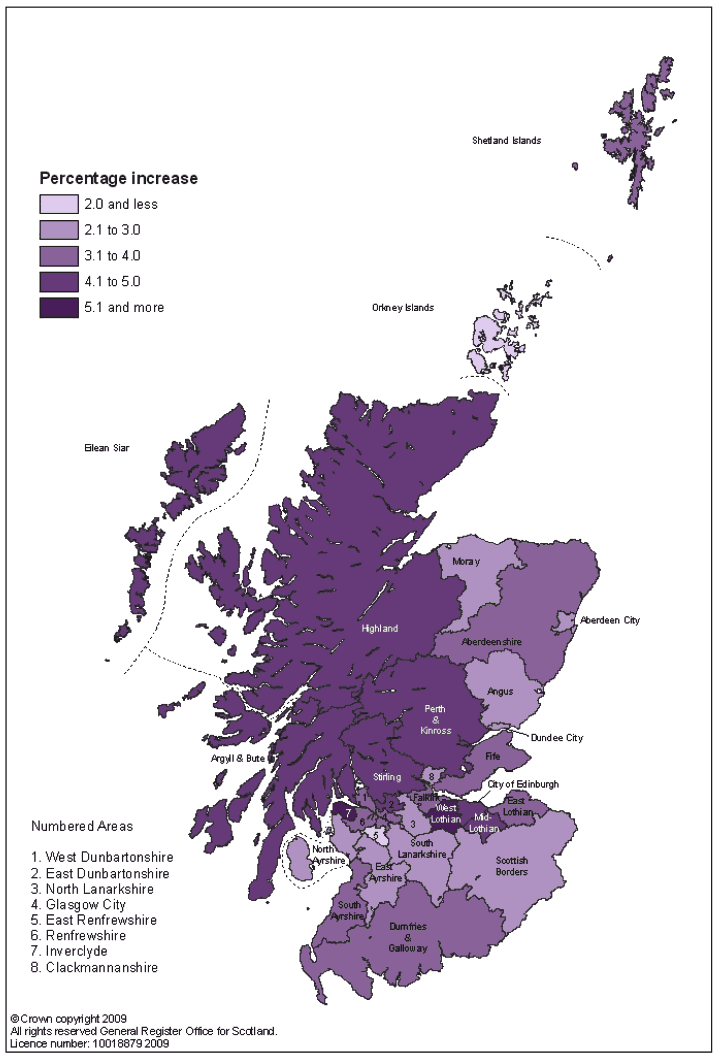
Figure 7b Percentage increase in life expectancy at birth between 1996-1998 and 2006-2008, Council areas, Females
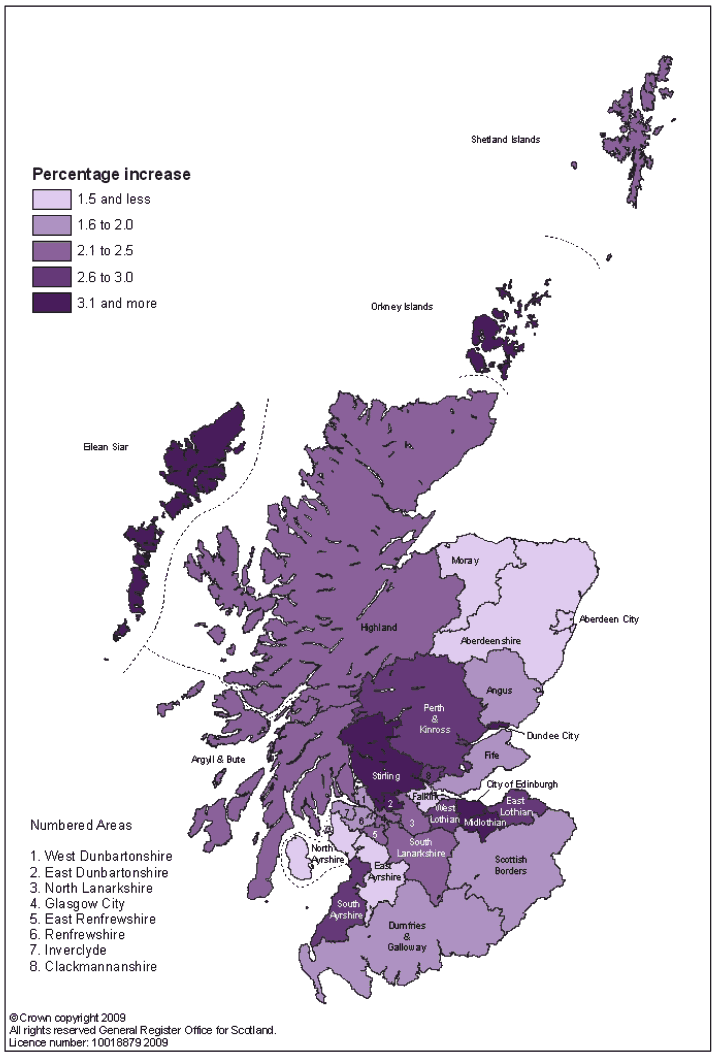
Figure 7c Percentage increase in life expectancy at birth between 1996-1998 and 2006-2008, Council areas, Males and Females
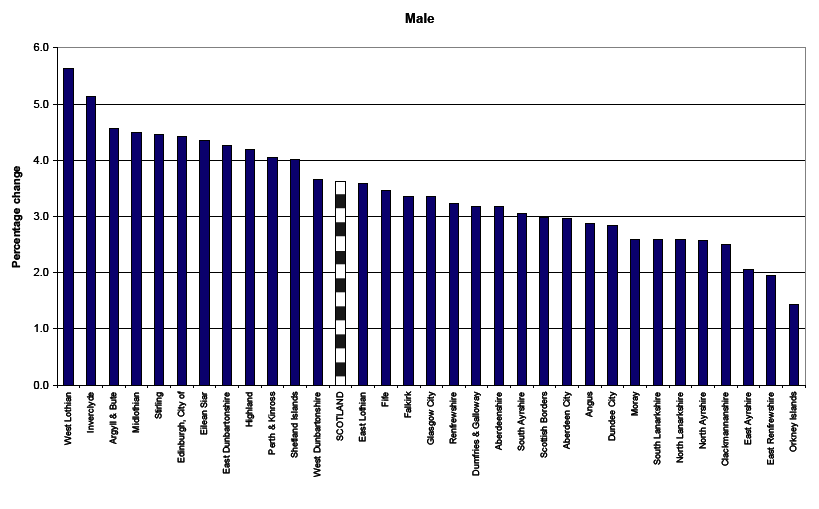
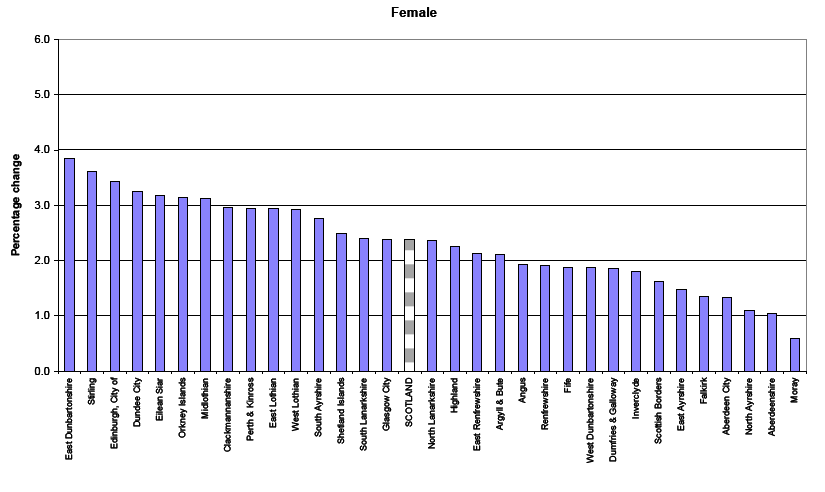
Figure 8a Percentage increase in life expectancy at birth between 1996-1998 and 2006-2008, NHS Board areas, Males
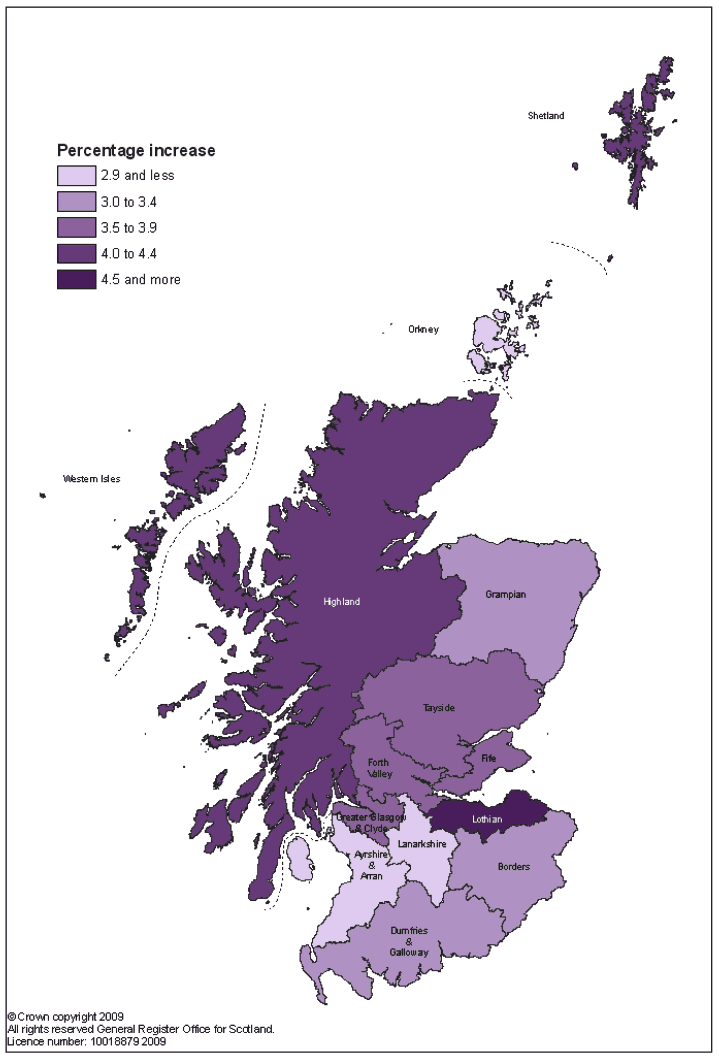
Figure 8b Percentage increase in life expectancy at birth between 1996-1998 and 2006-2008, NHS Board areas, Females
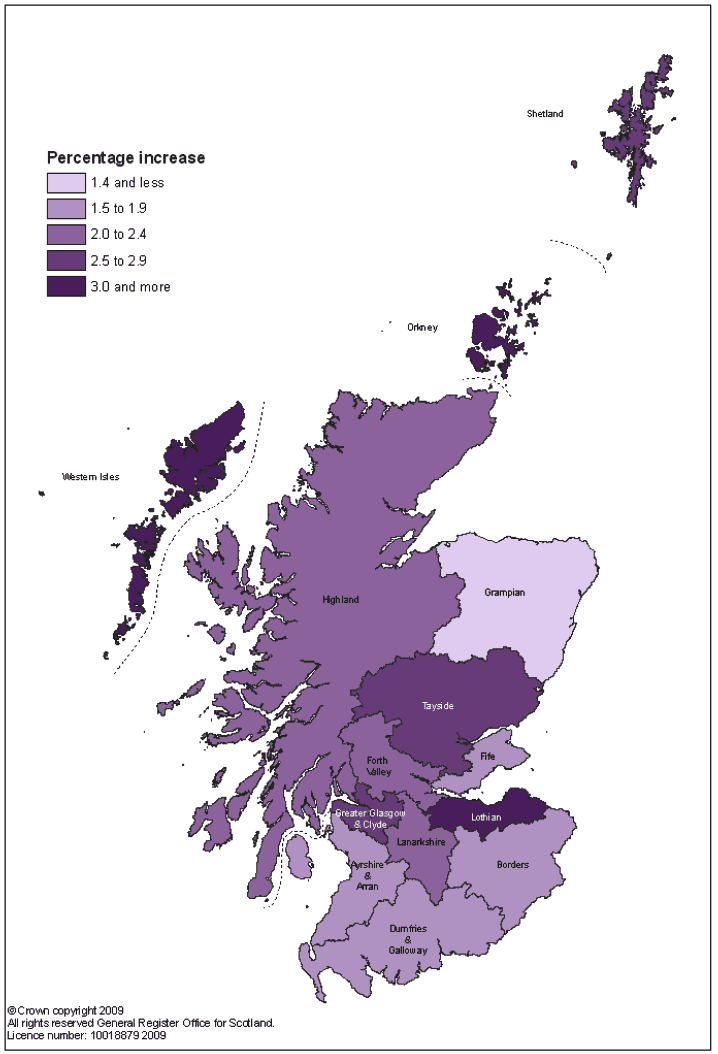
Figure 8c Percentage increase in life expectancy at birth between 1996-1998 and 2006-2008, NHS Board areas, Males and Females
